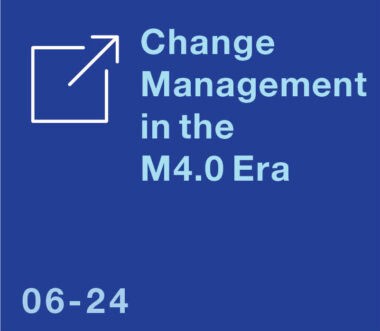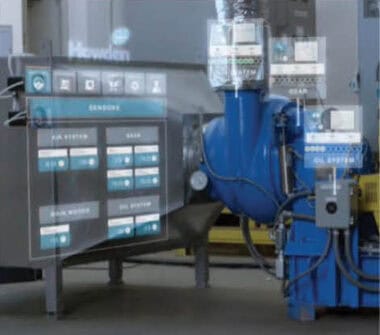A Multi-Dimensional Approach to Managing Change

Technology changes how work gets done, but leaders must also prepare and allow for a more empowered workforce.

TAKEAWAYS:
● Manufacturing 4.0 technologies such as connected devices, extended reality, and AI are ushering in a new era of manufacturing. These technologies represent a “deepening digitization” that is compatible with existing systems while empowering frontline workers.
● Connected devices enable information sharing between machines and directly to workers. At the same time, AI and XR help make large volumes of data accessible and actionable for workers on the factory floor.
● However, the biggest roadblock is often an organizational culture that is resistant to change. Starting small with enthusiastic teams and measurable pilot programs is recommended for smoothly integrating these technologies.
Many companies have mastered today’s industrial processes and may have even become overly complacent. However, emerging technologies including connected devices, extended reality, and artificial intelligence are once again creating a new era in the history of work – M4.0.
Despite making work safer and more efficient, these technologies face significant barriers to adoption. While these barriers include knowledge of technology and the cost to invest in hardware and software, the biggest barrier to adoption is reluctance to change. Effective change management is essential to the implementation of sustainable technological advances.
M4.0 as Deepening Digitalization
The last recent change in the manufacturing industry was the digitalization of many aspects of production. These changes brought benefits such as more accurate process optimization and more effective knowledge capture and transfer. It also made many processes more specialized.
The data that was captured couldn’t always be accessed, understood, or used by the frontline worker. For many workers, this meant more instructions from the top — a relationship that many managers are only too happy to maintain.
 “M4.0 is both compatible with existing management and optimization systems and more empowering to the average worker.”
“M4.0 is both compatible with existing management and optimization systems and more empowering to the average worker.”
At first glance, M4.0 looks like more of the same since it is driven by even more complex and nuanced and less familiar emerging technologies. The nature of M4.0 is, in many ways, a “deepening digitalization” of work. That means that it is both compatible with existing management and optimization systems and more empowering to the average worker.
Connecting the Worker
Existing digitalization trends have created more information, but too often that information has been siloed both from other sources of information and from the worker who created it first and needs it most.
A key component of M4.0 is connected devices that share information with each other. On a factory floor where many machines perform different tasks to make a single product, connected devices enable more efficient process optimization because all the information from all the devices is presented in a single context. Moreover, when devices are directly connected, some of these elements can be automated in networks of machines that work more like colleagues than tools.
But M4.0 isn’t just about connecting devices – it’s about connecting the worker. Connected devices mean more information from more places with more possibilities than ever. Without some of the other key technologies of M4.0, it would only perpetuate many of the problems inherent in the existing digitalization of work.

“Even with AI, the volume of information made available to frontline workers from connected devices could be overwhelming.”
People often talk about AI replacing frontline workers, but this is a misconception. While robots are increasingly becoming a part of factory floors, they are most often used by human workers (rather than instead of human workers) to perform difficult and dangerous tasks. However, some analysts may find AI taking over as it interprets and presents information from connected devices directly to workers on the factory floor.
Here, another emerging technology comes into play. Even with the help of AI, the volume of information made available to frontline workers from connected devices could be overwhelming. Augmented reality and IoT technology can turn large volumes of information and real-time data into easy-to-understand visual formats, available on mobile devices and wearables.
The Benefits of Connected Work
To bring it all together, what are the benefits of connected work? There are two important ways to answer this question: at the worker level and at the company level.
At the worker level, faster access to more accessible information leads to greater efficiency and greater job satisfaction. Being able to get the information that they need when and where they need it in a way that enhances rather than erodes their situational awareness means that workers can do a better job at a faster pace with fewer incidents. Meanwhile, being able to get that information on their own rather than relying on management, subject matter experts or co-workers to provide it to them means that workers can act and rightly feel more independent. This isn’t just a tool for communicating procedure directly from management to the floor. It can also help automate knowledge transfer to newer hires without putting undue pressure on more experienced workers.
At the company level, connected work means that work is done more safely with faster throughput and fewer mistakes. This doesn’t just mean faster production; it means more reliable production. That more than pays for itself in terms of improved customer satisfaction, but it also means reduced cost from rework. Products are more likely to be made right the first time, while defects are more likely to be located and addressed before shipping.
The Role of Change Management
So, where does change management come in? The greatest barrier to adopting M4.0 technologies isn’t cost, availability, or awareness. According to a recent survey by the Manufacturing Leadership Council, “the most significant roadblock to implementing a smart factory strategy is an organizational structure or culture that resists change.”
Technologists are quick to talk about what a major shift these emerging technologies pose for industry and quick to tout the benefits. However, they seldom mention that implementing major changes can be challenging. It is the job of change management to play both parts – mitigating the challenges to M4.0 adoption to realize the most benefits with the least disruption. But how?
One approach is to help everyone to understand that these technologies benefit everyone, both individually and as a company. Manage concerns on the part of the engineers from stories about workers being “replaced” and manage expectations from supervisors who might think that this technology can be effectively implemented overnight for high returns the next day.

“It is the job of change management to mitigate the challenges to M4.0 adoption to realize the most benefits with the least disruption.”
One practical and actionable approach is to find your champion and start small. While you continue to research technologies and the companies that provide them, keep your eyes open for the departments, teams, and team leaders that will be the most enthusiastic about emerging technologies. Most success stories of M4.0 implementation come not necessarily from presidents and executives with an eye toward the future, but from middle managers with the foresight to put together a pilot program.
Identifying a single process or product to test these technologies with the support of open-minded workers will be an easier battle than trying to automate an entire campus all at once. Focusing a more manageable budget to address more measurable variables will make for a great use case both in terms of how much these technologies have to offer your company, and in terms of the best way to gracefully integrate these technologies into your company’s unique structure and culture.
Making Change
Implementing these emerging technologies can feel like an uphill battle at first. But, in many workplaces, the workers who resist the idea are the ones that have the most to benefit from it. To effectively and sustainably implement M4.0 technologies, let them speak for themselves through hands-on pilot programs. M
About the author:

Dirk Schart is Senior Director Go-to-Market at PTC.